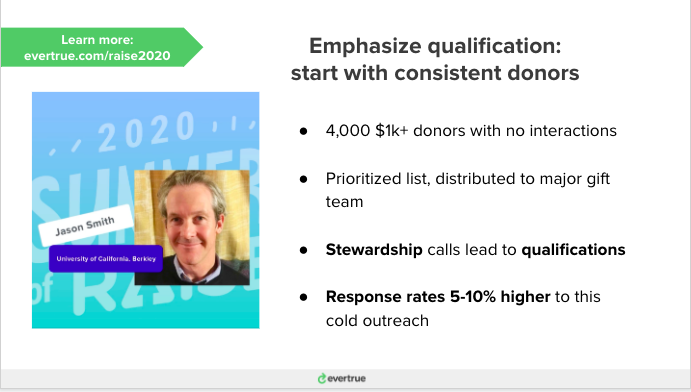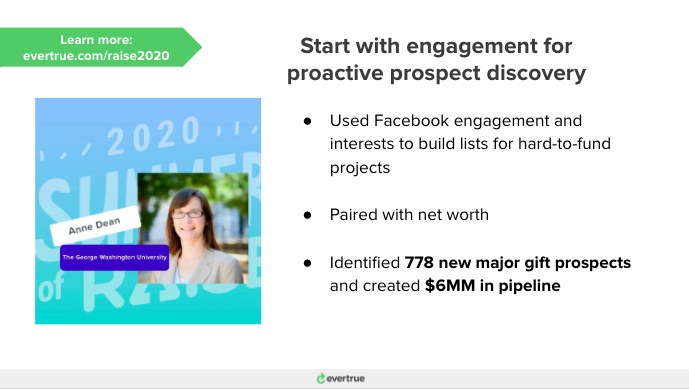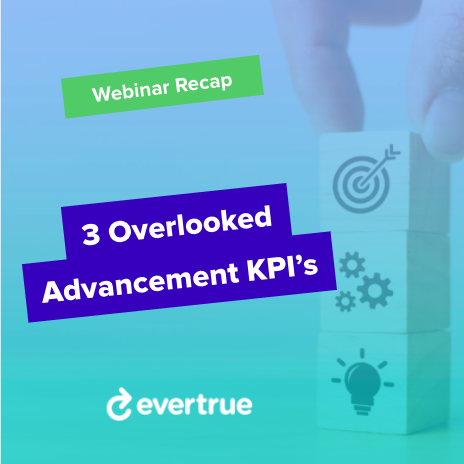We’re recapping our recent webinar highlighting 3 key performance indicators that every advancement organization needs to focus on in FY21 and beyond. In this series, we’ll dig into why donor retention, gift pipeline, and personal stewardship are the three metrics your team needs to focus on during FY21 and beyond.

Major gift pipeline
We’ve said it before and we’ll say it again: the importance of building a strong pipeline cannot be overstated. Catalant’s Pat Griffin outlined the benefits of a great pipeline in his RAISE 2019 session. (Remember when we could go to in person events?)
In the sales world, most companies want their reps to aim for 3x pipeline coverage. So if a sales rep’s quarterly revenue target is $100, then they need to have $300 in potential deals. The same philosophy applies to major gift fundraising, where the common expectation is one out of every three gifts will close.
(We should mention that there are good arguments against arbitrarily assigning a 3x pipeline goal. The best gift officers and sales reps regularly close more of their pipeline than most because they don’t chase donors or deals that aren’t yet ready to come in.)
However, during last week’s webinar, 55% of attendees said they were worried about the quality of their major gift pipeline.
In today’s uncertain financial climate, some donors are in a holding pattern when it comes to making big gifts. They want to give, and they will give, but they’re waiting to see how the economy shakes out.
To hit revenue and fundraising goals in this environment, advancement teams are going to need more pipeline.
The two ways to grow pipeline are increasing fundraising activities or closing more than 1 out of every 3 gifts. To do either, you need to get in front of more qualified and engaged prospects. Here’s how the University of California, Berkeley and The George Washington University are doing just that.
The University of California, Berkeley
Major gift officers turn stewardship calls into donor qualifications and solicitations.

At every institution, donors fall through the cracks. It happens. There’s not enough time in the day or gift officers to travel and see all the committed, wealthy, engaged donors in the world.
But we’re not traveling now. That means there’s more time to reach out to unreached donors, thank them for their support, and see what they’d like to do in the future.
Berkeley identified 250 people who had given $1,000 four years in a row but weren’t yet managed prospects or had contact with a fundraiser in the last 12 months.
“The idea was that these people would be more receptive to a phone call than a highly rated, yet unengaged prospect,” said Jason Smith, Executive Director of Major Gifts. “Our major gifts team is focused on major gifts outcomes, and there’s a lot of data that shows people who give $1,000 or more for multiple years are much more likely to have a philanthropic conversation that leads to greater gifts.”
Each member of Jason’s major gifts team received about 25 prospects they were supposed to connect with during the first quarter of FY21. They’ve seen a much higher response rate to their outreach than past campaigns — between five to 10 percentage points higher, depending on region — and many of these prospects have moved into major gift conversations.
With travel either on hold or significantly slowed in the coming months, there’s more time for gift officers to not only engage the prospects within their portfolios but to also steward and qualify the most promising current donors and rapidly add to the existing pipeline.
Learn more about UC Berkeley’s project by watching Jason’s RAISE presentation. (21-min video)
The George Washington University
Starting with donor interests and engagement to build a pipeline for hard-to-fund projects.

In just a few months (and during the pandemic), the Division of Development and Alumni Relations at George Washington University has identified nearly 800 new major gift prospects for three distinct projects, creating more than $6 million in new pipeline.
The prospect research team looked beyond majors and student activities to build prospect lists for dormitory renovations, a new building for Hillel, and its Colonial Athletics teams. Using Evertrue, they found wealthy donors who were actively engaging with Facebook posts related to these programs or who had mentioned interest in giving to these areas in the past.
“EverTrue shows you who’s a warmer lead than you think. Our CRM doesn’t show that. EverTrue shows us who’s warm, engaged, and likely to give,” said Anne Dean, Managing Director of Research and Relationship Management. “When we uncover a new prospect, we can see how they’re connected with us and that they’re engaging right now. It helps us make the referral and say, ‘Go, go, go!” to the gift officer.”
Fundraisers know mere capacity isn’t enough. The best prospects are not only wealthy, but their interests align with the university’s needs and they’re actively engaged with the institution. When you connect wealth, engagement, and interest, gifts just close faster.
Learn more about The George Washington University’s pipeline building strategies. (11-min video)
Build a better gift pipeline
Gift officers have more time to make virtual visits, work qualification pools, cultivate donors, and build pipeline. When they reach out to warm prospects — those who are already giving or engaged with the institution — they can open more proposals. And those gift proposals are much more likely to close because they’re aligned to the donor’s interests.
If you’d like to see how EverTrue can help you build pre-qualified prospect pools, automatically identify warm leads, and manage portfolios and virtual visits, we’d love to show you.
If you just can’t wait for part 3, watch the full webinar recording here:
Full webinar recording: 3 KPIs for Advancement During COVID-19 and Beyond
